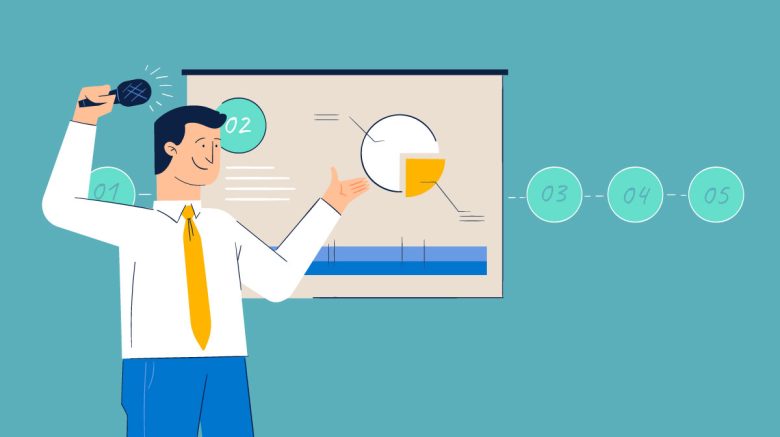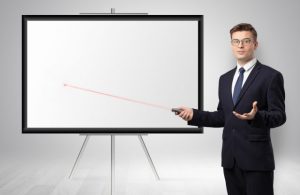There are many things to consider when preparing for an interview, from what to wear to what questions you’ll be asked. One important aspect of the interview process that can often be overlooked, however, is making a presentation.
Whether you’re asked to give a presentation on your experience, your qualifications, or your goals, making a strong presentation can be the difference between getting the job and not. Here are a few tips on how to make a presentation that will impress your interviewer:
1. Start with a strong introduction.
Your introduction is your opportunity to capture your audience’s attention and introduce them to your topic. Make sure to state your thesis statement clearly and concisely, and use strong visuals to help illustrate your points.
2. Organize your information effectively.
Your presentation should be well-organized and easy to follow. Make sure to use clear and concise language, and use headings and subheadings to help your audience understand your points.
3. Stay on topic.
It’s important to stay on topic throughout your presentation. If you find yourself digressing from your main points, take a moment to refocus and get back on track.
4. Be clear and concise.
Your audience will only remember a fraction of what you say, so make sure to be clear and concise in your presentation. Use strong visuals and short, easy-to-understand sentences to get your points across.
5. Practice, practice, practice.
It’s important to practice your presentation before you go in for your interview. This will help ensure that you stay on track and that your points are clear.
Making a strong presentation can be the key to impressing your interviewer and landing the job. By following these tips, you can make a presentation that will leave a lasting impression.
How do I make a good PowerPoint presentation for an interview?
There is no one definitive answer to this question. However, there are a few tips that can help you create a good PowerPoint presentation for an interview.
First, it is important to tailor your presentation to the specific audience that you will be addressing. For example, if you are interviewing with a company for a specific position, you will want to tailor your presentation to highlight your skills and experience that are relevant to that position.
Second, be sure to use clear and concise language throughout your presentation. This is especially important when delivering your presentation orally. Avoid using jargon or technical terms that may be unfamiliar to your audience.
Third, make sure your presentation is well-organized and easy to follow. Use clear headings and subheadings to help your audience follow along, and be sure to provide ample visual aids to support your points.
Finally, practice delivering your presentation aloud several times before the actual interview. This will help you become more comfortable with the material and will help you to appear more confident when giving your presentation.
What should be included in a presentation interview?
A presentation interview is a job interview in which the interviewer asks the job candidate to present a project or presentation they have created. This type of interview is often used for positions in which the candidate would be required to give presentations to clients or customers.
There are a few things to keep in mind when preparing for a presentation interview. First, make sure you know the format of the interview. Some interviews will ask you to present your project from start to finish, while others may ask you to focus on specific aspects of the project. It is important to be prepared for both types of interviews.
Second, practice your presentation. It is important to be confident and comfortable with your presentation. Practice in front of a friend or family member to get feedback and make sure you are ready for the interview.
Finally, be sure to bring a copy of your presentation to the interview. This will allow the interviewer to follow along and ask questions.
When preparing for a presentation interview, be sure to include the following:
-The purpose of the presentation -The target audience -Your main points -How you will engage the audience -The conclusion of the presentation
Be sure to also practice your delivery. Make sure you are confident and comfortable with your presentation. Practice in front of a friend or family member to get feedback.
Is it OK to make a presentation for job interview?
Yes, it is OK to make a presentation for a job interview. In fact, some employers may even prefer it. A presentation can show off your skills and highlight your strengths.
When preparing your presentation, be sure to focus on the most important points you want to make. Keep it concise and make sure your message is clear. Practice your presentation so you can deliver it effectively.
Be sure to dress for the occasion and be professional in your demeanor. Arrive on time and be prepared to answer questions from the employer.
A presentation can be a great way to show off your skills and impress a potential employer. It can also help you stand out from the competition.
What should I say in a presentation for an interview?
When preparing for a job interview, one of the most important things to focus on is your presentation. This is your opportunity to make a great first impression and sell yourself to the interviewer. To make sure you make the most of this opportunity, follow these tips:
1. Know your audience.
Before you start preparing your presentation, take a moment to think about who will be watching it. This will help you tailor your content to their needs and interests.
2. Start with a strong introduction.
Your introduction should be concise and interesting, setting the tone for the rest of your presentation. It’s a good idea to highlight your qualifications and experience, as well as what you can bring to the company.
3. Make sure your content is relevant.
Your presentation should be relevant to the job you’re interviewing for. Make sure to focus on your skills and experience, and how they can benefit the company.
4. Use visual aids.
Visual aids can be helpful in illustrating your points and keeping your audience engaged. However, be sure to use them sparingly, and make sure they are relevant to your content.
5. Stay focused.
It can be easy to lose focus when giving a presentation. But it’s important to stay on track and keep your audience engaged. If you find yourself losing your train of thought, take a moment to regroup and get back on track.
6. Practice, practice, practice.
It’s important to practice your presentation before you go into the interview. This will help you feel more confident and ensure that your content is clear and concise.
7. Be prepared for questions.
The interviewer may ask you questions about your presentation. Be prepared to answer them, and have a few anecdotes and examples ready to illustrate your points.
Giving a great presentation during a job interview is essential for making a good first impression. Follow these tips to make sure you make the most of this opportunity.
What do you say at the beginning of an interview presentation?
When you’re giving a presentation in an interview, the most important thing is to make a good first impression. You want to make sure that you come across as confident and competent.
There are a few things you can do to make sure your presentation is off to a good start. First, make sure you know your audience. Tailor your presentation to their needs and interests.
Also, make sure you have a clear goal for your presentation. What do you want the audience to takeaway from your talk?
Finally, make sure you practice your presentation. Rehearse it in front of a friend or family member, and make sure to time yourself. You don’t want your presentation to be too long or too short.
When you’re ready to give your presentation, make sure to start with a strong opening. Introduce yourself and your topic, and give the audience a brief overview of what you’ll be talking about.
Then, dive into your presentation. Be clear and concise, and make sure to keep your audience engaged.
Finish up your presentation with a strong closing. Thank the audience for their time, and remind them of the main points you discussed.
And that’s how you give a successful interview presentation!
How do you start a speech for an interview?
Giving a speech in an interview setting can be a nerve-wracking experience, but with careful preparation it can be a successful one. Here are four tips for starting your speech:
1. Establish rapport
When you first meet your interviewer, take a moment to establish rapport. This means being friendly and showing that you’re interested in getting to know them. You can do this by asking them questions about their background or their work.
2. State your qualifications
Your interviewer will likely want to know why you’re the best person for the job. Make sure to state your qualifications early on in your speech. This can include your education, your work experience, and your skills.
3. Explain your motivation for applying
Your interviewer will want to know why you’re interested in the job. Take a moment to explain your motivation for applying. This can include why you’re passionate about the company’s mission or why you’re excited about the job itself.
4. Close with a strong statement
Your interviewer will want to know what you’ll bring to the table if you’re hired. Make sure to end your speech with a strong statement that highlights your qualifications. You can also mention why you’re excited to work for the company.
How do you start a Powerpoint presentation for an interview?
There are a few things to keep in mind when starting a Powerpoint presentation for an interview. First, you want to make sure that your presentation is well-organized and easy to follow. You should also make sure to highlight your strengths and qualifications, and to practice your presentation ahead of time.
When creating your presentation, it’s important to start with a strong introduction. You should introduce yourself and explain why you’re interested in the position. Next, you should outline your qualifications and experience. Be sure to highlight your strengths and explain how they would benefit the company.
In your conclusion, you should reiterate your qualifications and explain why you’re the best candidate for the job. Thank the interviewer for their time, and be sure to ask any questions you have.
How do you structure a PowerPoint presentation for an interview?
There is no one definitive way to structure a PowerPoint presentation for an interview. However, there are a few key things to keep in mind when creating your presentation.
First, make sure that your presentation is clear and concise. It is important to be able to quickly and easily communicate your ideas to your interviewer.
Second, be sure to tailor your presentation to the specific job you are interviewing for. The content of your presentation should highlight your skills and experience relevant to the position you are applying for.
Finally, practice your presentation beforehand. This will help you to feel more confident when delivering it in front of your interviewer.
What is the 10 20 30 Rule of PowerPoint?
The 10-20-30 rule is a guideline for effective PowerPoint presentations. According to this rule, a presentation should have no more than 10 slides, last no more than 20 minutes, and have no more than 30 points.
The 10-20-30 rule is based on the idea that a presentation should be concise and focused. Too many slides can overwhelm a viewer, while too little information can be frustrating. A presentation that lasts too long can be tedious and boring, while one with too many points can be difficult to follow.
There is no one right way to follow the 10-20-30 rule. Some presenters may choose to have 10 slides that last for 20 minutes, while others may have 20 slides that last for 10 minutes. The most important thing is to be concise and focused.
The 10-20-30 rule is a guideline, not a rule set in stone. There are always exceptions to the rule. If a presentation requires more than 10 slides, or if it needs to last for more than 20 minutes, then go ahead and break the rule. Just make sure that the presentation is still concise and focused.
What is the 5 5 5 rule for presentation?
The 5 5 5 rule for presentation is a simple guideline to follow when giving a presentation. The rule is to speak for no more than five minutes, take five minutes for questions, and have no more than five slides. This guideline helps to keep presentations concise and to the point.
When giving a presentation, it is important to be clear and concise. The 5 5 5 rule helps to ensure that presentations are short and to the point. This rule keeps presentations under a half hour, which is typically the maximum amount of time that people are willing to listen to a presentation.
The 5 5 5 rule is also helpful for keeping presentations organized. When presenting, it is helpful to have a clear structure and to stick to a specific time limit. This rule helps to ensure that presentations are well organized and easy to follow.
The 5 5 5 rule is a helpful guideline to follow when giving a presentation. It ensures that presentations are concise and well organized.
What should be included in a presentation for an interview?
When you are going in for an interview, one of the most important things you can do is to prepare a presentation. This presentation is your opportunity to highlight your skills and experience, and to show the interviewer that you are a great fit for the job.
Your presentation should include the following:
1. An introduction
2. Your skills and experience
3. Why you are a good fit for the job
4. A conclusion
When creating your presentation, be sure to tailor it to the specific job you are interviewing for. Highlight the skills and experience that are relevant to the job, and focus on why you are the best candidate for the position.
Your presentation should be clear and concise, and it should be easy for the interviewer to understand your qualifications. Be sure to practice your presentation ahead of time, so that you can deliver it confidently and effectively.
The interviewer will be looking for evidence that you are a qualified and capable candidate, and your presentation is your opportunity to show them what you have to offer. Be sure to make the most of this opportunity, and you will increase your chances of getting the job.
How do you start an interview presentation?
An interview presentation is a great way to stand out from the other applicants and show the interviewer that you are truly interested in the job. It can also help to clarify any questions the interviewer may have about your qualifications.
The best way to start an interview presentation is by introducing yourself and highlighting your qualifications. Be sure to mention why you are interested in the job and what you can bring to the organization. You should also be prepared to answer any questions the interviewer may have about your presentation.
If you are well-prepared, your interview presentation will help you stand out from the other applicants and improve your chances of getting the job.
Should I prepare for a presentation interview?
When you are interviewing for a job that involves giving presentations, the interviewer will likely ask you to give a presentation on a topic of your choice. This is your opportunity to show the interviewer your speaking skills and your ability to think on your feet.
There are a few things you can do to prepare for a presentation interview:
1. Research the company and the industry.
The better you understand the company and the industry, the more confident you will feel in your ability to give a presentation on a relevant topic.
2. Practice your presentation.
It is important to practice your presentation so that you can ensure that it is well-organized and flows smoothly.
3. Know your audience.
The better you know your audience, the more tailored your presentation will be.
4. Anticipate questions.
The interviewer will likely ask you questions about your presentation, so be prepared to answer them.
5. Stay calm and confident.
It is important to stay calm and confident during your presentation. Remember, you are the expert on the topic, so there is no need to be nervous.
How to do a 5 minute presentation for an interview?
In order to make a great impression in a job interview, you may be asked to give a five-minute presentation on a topic of your choosing. This can be a daunting task, but with careful preparation you can ace it.
Your presentation should be clear, concise, and well-organized. Start by introducing yourself and your topic, then briefly outline your main points. Make sure to use strong evidence and examples to support your argument.
End your presentation with a strong conclusion, and be prepared to answer questions from the interviewer. Stay calm and confident, and remember to smile and make eye contact. If you follow these tips, you’ll be sure to make a great impression in your next job interview.
Should I do a PowerPoint presentation for an interview?
A PowerPoint presentation can be a great way to show off your knowledge and qualifications for a job during an interview. However, there are a few things to keep in mind before you decide to use this tool.
First, make sure that your PowerPoint is well-organized and easy to follow. Bullet points and concise statements work best, and you should avoid overcrowding your slides with text.
Second, make sure that your PowerPoint is tailored to the job you are interviewing for. If you are applying for a position in marketing, for example, your PowerPoint should focus on your marketing skills and experience.
Finally, be sure to practice your presentation ahead of time. This will help ensure that your slides are clear and easy to understand.
If you follow these tips, you can use a PowerPoint presentation to make a great impression on your interviewer and increase your chances of getting the job.
How do you present a presentation for an interview?
When you are invited for an interview, one of the most important things you need to do is to prepare for the interview. This means that you will need to practice your presentation and be familiar with the content. In some cases, you may also be asked to give a presentation as part of the interview process.
The best way to present a presentation for an interview is to be prepared and confident. Make sure that you know your material well, and practice your presentation several times before the interview. Be aware of the time limit, and make sure to leave time for questions at the end.
When you deliver your presentation, speak clearly and confidently. Make eye contact with your audience, and use gestures to emphasize key points. Be aware of your body language, and make sure to stay relaxed and engaged.
If you are asked to answer questions after your presentation, be prepared to respond to a wide range of questions. Stay calm and concise, and make sure to answer all questions fully.
By preparing well and delivering your presentation with confidence, you can make a positive impression on your interviewer and increase your chances of getting the job.
What should you never do in a job interview?
There are a few things you should never do in a job interview, no matter how desperate you are for the job.
1. Don’t be late. Punctuality is extremely important in a job interview. If you’re late, you’re already starting off on the wrong foot.
2. Don’t be rude. Even if you’re not interested in the job, be polite and respectful to the interviewer.
3. Don’t badmouth your old boss. Whatever happened with your last job, don’t talk bad about your old boss or company.
4. Don’t lie. If you’re caught in a lie, you’re pretty much guaranteed to not get the job.
5. Don’t dress inappropriately. Dress for the job you want, not the job you have. That means no jeans, no sneakers, and no T-shirts.



